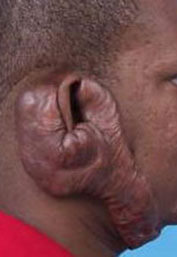Keloid is a condition concerning a scar formed by an abnormal process in the body. It is commonly associated with certain ethnic groups like African Americans and Asians. Initiated by fibroblasts, signals are received from skin cells called keratinocytes. The signal to the fibroblasts overproduces collagen leading to extra scar formation. We cut out the keloids and let the skin heal.
What are some of the symptoms of keloids? Pain and itching can be associated with keloids. The constant presence of these symptoms can be distracting and affect someone’s quality of life. And the unsightly appearance of keloids can be the main issue.
What are the causes of keloid? Genetics play a major role. However, keloids can occur in anyone and in any ethnicity. Tension and persistent inflammation can lead to keloids. Areas with poor hygiene or persistent presence of infection can also lead to the formation of keloids.
Where do keloids most likely to occur? The sternum is the most prone to form keloids, who most common on the chest, shoulders, back, earlobes and sometimes along the jawline. The eyelids rarely develop keloids.
The best option. If you are prone to keloids, avoid elective surgery.
A chemotherapy agent, can slow or shrink the growth of keloids.
Interferon injections are being studied and have shown promise. The future use of fluorouracil, interferon and steroids may lead to progress but need further study.
Freezing of keloids have been used but can be hard to control. An outdated treatment, liquid and the form present variability and difficulty of controlling its use.
Radiation therapy can lead to complications and the development of future cancers.
Laser therapy like CO2 lasers have been used to remove keloids. Unfortunately, recurrence is common for keloids. Intense pulse light and other laser therapy attack red vessels and hemoglobin (V beam) in the range of 530 to 590 nanometers. It can attack the vessels that feed the keloid process and decrease the size and red appearance of the keloid.
Steroid therapy and injections can also decrease the size of keloids. However, the results are inconsistent and vary from patient to patient. In our experience, new keloids respond more to steroid injections than mature keloids. Steroids are important during the post excision phase of keloid treatments.
After taking out your keloids, we inject steroids four to eight weeks after treatment. If the area turns red and inflamed, four weeks is better. If the inflammation is kept at bay, eight weeks is fine. Once the redness and swelling stops, we consider stopping further steroid injections.
the main option for most surgeons to treat keloids with the help of steroid injections. We do up to six injections after the excision to keep the keloids from coming back. Surgical excision with healing by secondary intention takes out the scar and allows the wound to heal on its own. The skin migrates to the open wound and heals over it.
There are times when we need to stimulate the healing employing the wet to dry dressing technique for healing. The secondary intention is the best option because cutting the keloid out and letting the wound heal on its own is the most organic way. Through secondary intention healing, you are less likely to have a recurrence because your body is adapting and stretching the skin to allow the wound to close.

Before Excision of Large Keloid along Ear and Jawline with Healing by Secondary Intention

After Excision of Large Keloid along Ear and Jawline with Healing by Secondary Intention
Note: Individual results will vary. Images do not constitute a promise or representation of any particular outcome or experience.
Dr. Young is highly experienced in keloid scarring having spent five years at Los Angeles County’s head and neck reconstructive team during his residency and one year experience at Louisiana State University in Shreveport. He has more than 15 years of experience as a surgeon and also an author on the subject. Dr. Young wrote the "Treatment Large Keloids Secondary Intention Healing" in the American Journal of Cosmetic Surgery, Dec 2013.
